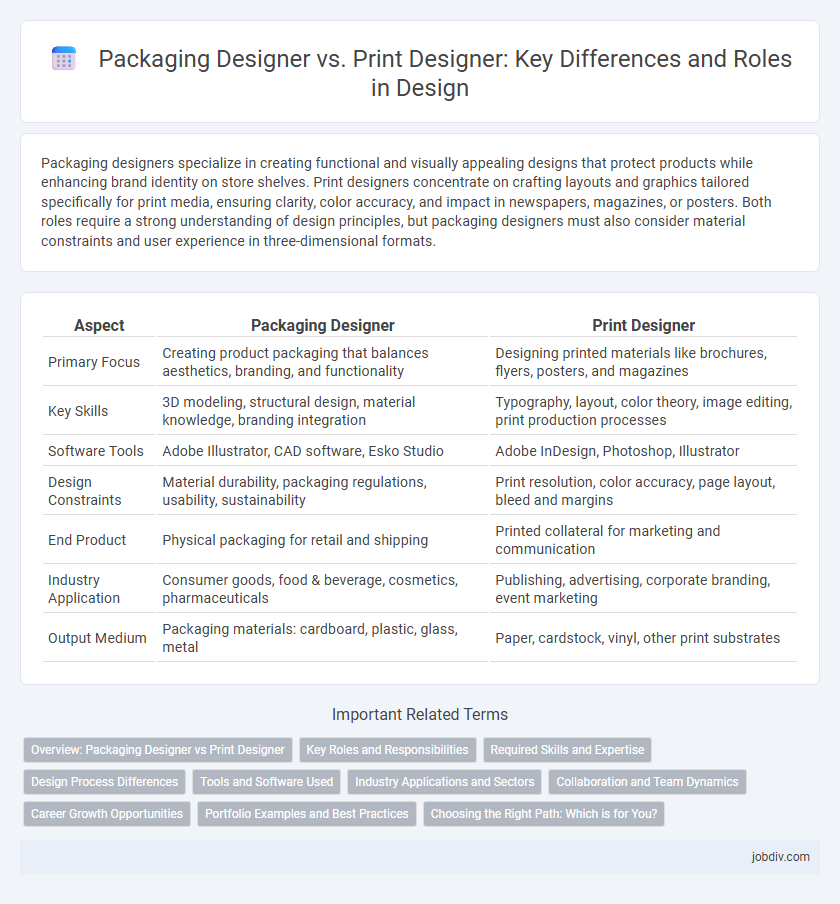Packaging designers specialize in creating functional and visually appealing designs that protect products while enhancing brand identity on store shelves. Print designers concentrate on crafting layouts and graphics tailored specifically for print media, ensuring clarity, color accuracy, and impact in newspapers, magazines, or posters. Both roles require a strong understanding of design principles, but packaging designers must also consider material constraints and user experience in three-dimensional formats.
Table of Comparison
| Aspect | Packaging Designer | Print Designer |
|---|---|---|
| Primary Focus | Creating product packaging that balances aesthetics, branding, and functionality | Designing printed materials like brochures, flyers, posters, and magazines |
| Key Skills | 3D modeling, structural design, material knowledge, branding integration | Typography, layout, color theory, image editing, print production processes |
| Software Tools | Adobe Illustrator, CAD software, Esko Studio | Adobe InDesign, Photoshop, Illustrator |
| Design Constraints | Material durability, packaging regulations, usability, sustainability | Print resolution, color accuracy, page layout, bleed and margins |
| End Product | Physical packaging for retail and shipping | Printed collateral for marketing and communication |
| Industry Application | Consumer goods, food & beverage, cosmetics, pharmaceuticals | Publishing, advertising, corporate branding, event marketing |
| Output Medium | Packaging materials: cardboard, plastic, glass, metal | Paper, cardstock, vinyl, other print substrates |
Overview: Packaging Designer vs Print Designer
A Packaging Designer specializes in creating visually appealing and functional packaging solutions that enhance product protection and consumer experience, integrating material selection, structural design, and branding elements. In contrast, a Print Designer focuses on crafting layouts and graphics specifically for print media such as brochures, posters, and business cards, emphasizing color accuracy, typography, and print production techniques. Both roles require strong design principles but differ in their medium constraints and project objectives within the design industry.
Key Roles and Responsibilities
Packaging designers specialize in creating functional and visually appealing packaging solutions that enhance product protection and shelf impact, focusing on materials, structure, and brand messaging. Print designers concentrate on layouts, typography, and color schemes for printed media such as brochures, posters, and magazines, ensuring clarity and print accuracy. Both roles require strong graphic design skills but differ in their emphasis on three-dimensional design versus two-dimensional print production.
Required Skills and Expertise
Packaging designers require expertise in structural design, materials science, and 3D modeling software such as ArtiosCAD or Esko to create functional and visually appealing packaging solutions. Print designers focus on typography, color theory, and layout using tools like Adobe InDesign and Illustrator to ensure high-quality printed materials. Both roles demand strong attention to detail, creativity, and knowledge of production processes, but packaging designers must also understand product protection and sustainability considerations.
Design Process Differences
Packaging designers prioritize material selection, structural integrity, and user interaction to develop functional yet visually appealing containers, emphasizing 3D design and prototyping. Print designers focus on color accuracy, typography, and layout within 2D formats, ensuring optimal print quality and readability across various media. The packaging design process integrates engineering constraints and branding, while print design centers on graphic composition and reproducibility on different paper stocks.
Tools and Software Used
Packaging designers primarily use 3D modeling software like Adobe Dimension, Esko Studio, and ArtiosCAD to create structural designs and visualize packaging prototypes. Print designers rely on layout and image editing tools such as Adobe InDesign, Photoshop, and Illustrator to prepare artwork for various print media. Both specialties benefit from Adobe Creative Cloud, but packaging design emphasizes dieline creation and product mockups, while print design focuses on color management and typography.
Industry Applications and Sectors
Packaging designers specialize in creating visually appealing, functional containers that enhance product appeal in retail, food and beverage, cosmetics, and consumer electronics industries. Print designers focus on producing high-quality printed materials such as brochures, posters, and magazines, serving sectors like advertising, publishing, and corporate branding. Both roles require knowledge of production processes, but packaging design emphasizes material durability and regulatory compliance, while print design centers on color accuracy and print techniques.
Collaboration and Team Dynamics
Packaging designers and print designers collaborate closely to ensure cohesive brand representation, with packaging designers focusing on structural functionality and print designers emphasizing visual aesthetics. Effective team dynamics require clear communication about material constraints, color accuracy, and production processes to harmonize design intent with manufacturing capabilities. Leveraging collaborative tools and cross-disciplinary feedback enhances innovation, streamlines workflows, and delivers consistent, high-quality packaging solutions.
Career Growth Opportunities
Packaging designers often experience rapid career growth due to the increasing demand for sustainable, innovative packaging solutions in industries like consumer goods and e-commerce. Print designers traditionally focus on creating visual content for physical media such as brochures and posters, offering steady career paths in advertising agencies and publishing. Specialized skills in 3D modeling and materials science give packaging designers a competitive edge in advancing to senior roles and creative director positions.
Portfolio Examples and Best Practices
Packaging designers showcase portfolios with 3D mockups, dielines, and material experiments highlighting product protection and brand storytelling. Print designers emphasize high-resolution layouts, typography, and color calibration samples that demonstrate print production skills and visual hierarchy. Best practices for both include clear project descriptions, client objectives, and before-and-after visuals to illustrate problem-solving and design impact.
Choosing the Right Path: Which is for You?
Packaging designers specialize in creating visually appealing and functional packaging that enhances product appeal and user experience, focusing on materials, structure, and branding. Print designers concentrate on layout, typography, and color schemes for printed materials like brochures, posters, and magazines to ensure clear communication and aesthetic impact. Choosing between packaging and print design depends on your interest in 3D structural creativity versus 2D visual storytelling and the industry you want to work within, such as consumer goods or marketing agencies.
Packaging Designer vs Print Designer Infographic

 jobdiv.com
jobdiv.com